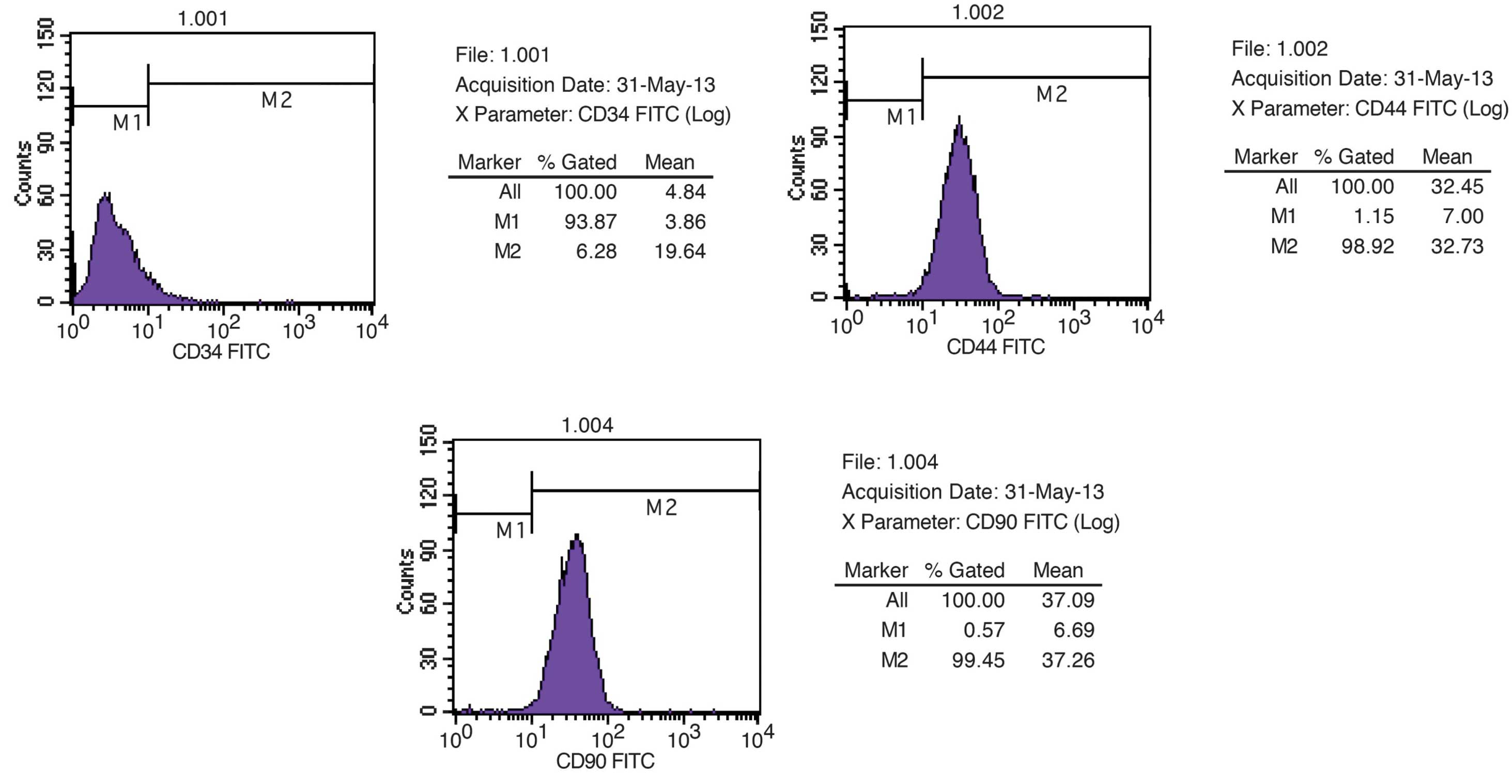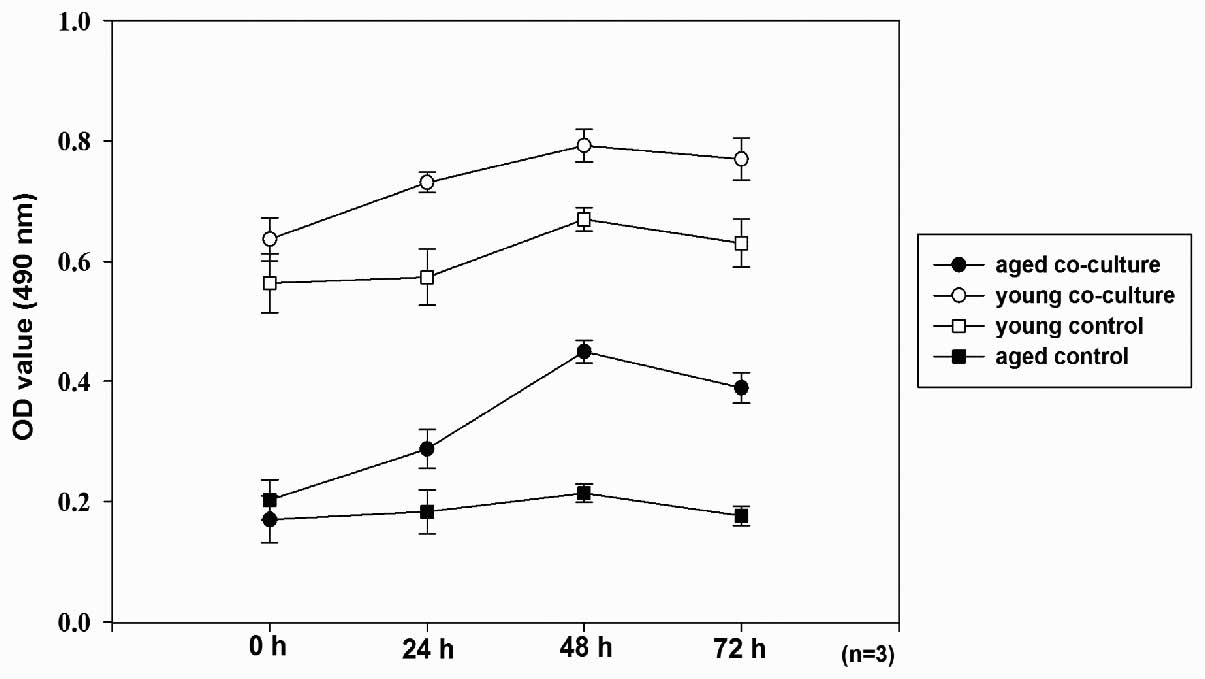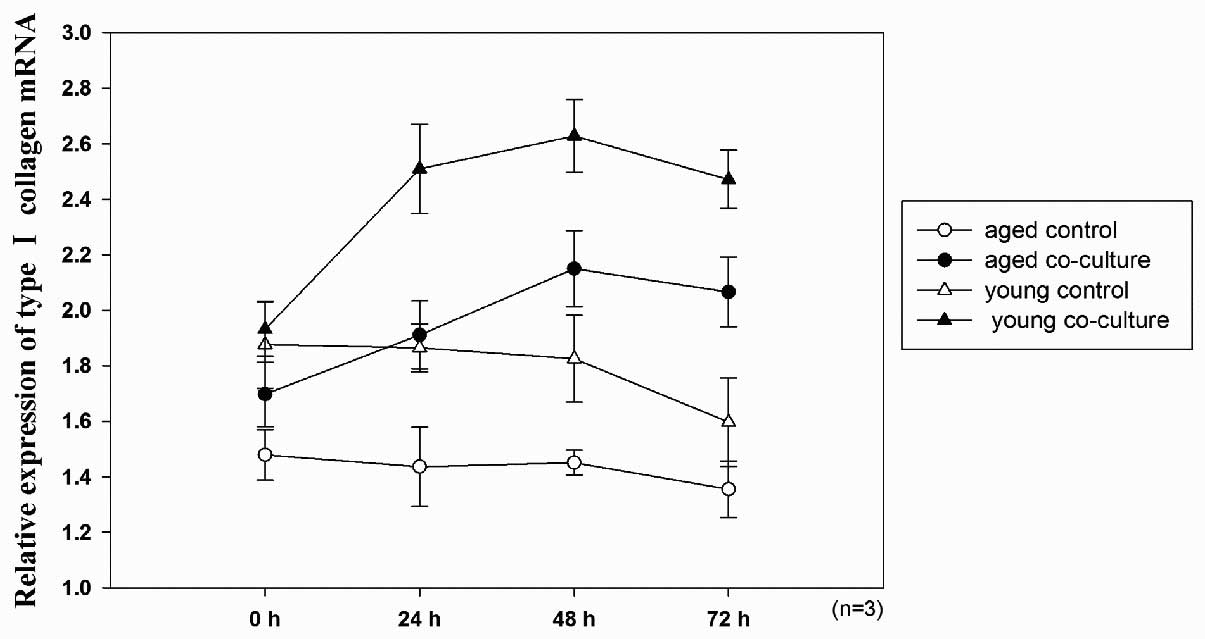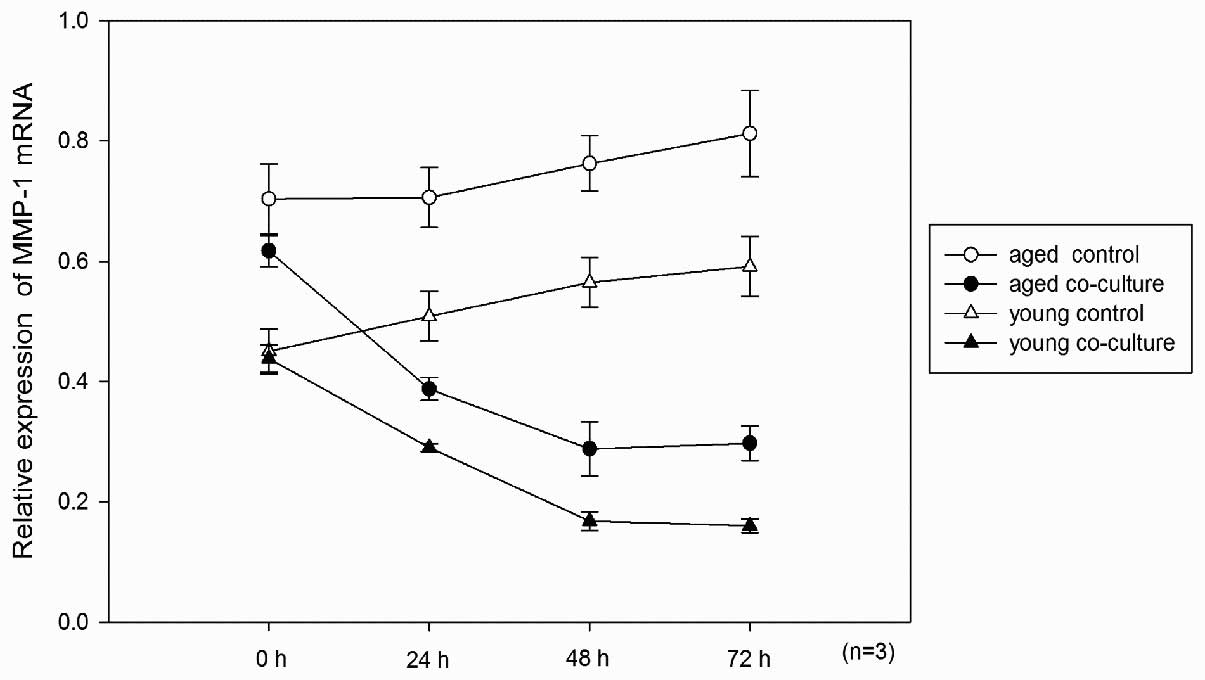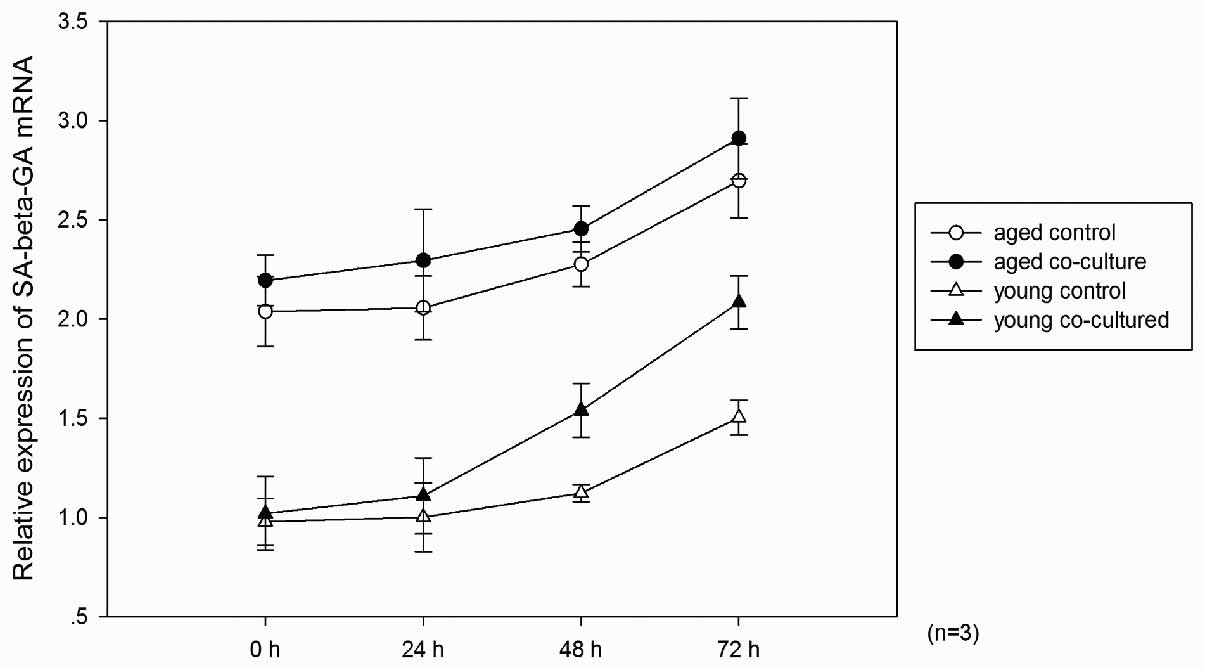Adipose-derived stem cells promote human dermal fibroblast function and increase senescence-associated β‑galactosidase mRNA expression through paracrine effects
- Authors:
- Published online on: October 13, 2014 https://doi.org/10.3892/mmr.2014.2627
- Pages: 3068-3072
Abstract
Introduction
Adipose-derived stem cells (ADSCs) are multipotent mesenchymal cells, which present similar cellular characteristics to bone marrow-derived stem cells (BMSCs) (1). ADSCs can be acquired from adipose tissue in large quantities during surgical procedures. The yield of mesenchymal stem cells from adipose tissue is markedly higher than that from bone marrow tissue. Similar to BMSCs, ADSCs secrete various dynamic cytokines. These cytokines are extensively involved in regenerative medicine, such as wound healing, tissue repair and anti-aging therapies (2–5).
Human dermal fibroblasts (HDFs) are imperative in human skin aging. They function in repairing dermal tissue and maintaining the integrity and youth of skin. During the aging process of skin, dermal fibroblasts exhibit a decline in cell number and cell function (6). The altered function of HDFs is a vital target for skin rejuvenation therapy. Traditional anti-aging therapy involves activation of dermal fibroblasts through laser or topical agents (5). However, stem cell therapy for aging has recently started to evolve. The therapeutic effects of menchymal stem cells have been widely studied. Previous studies have shown that ADSCs can promote fibroblast function in wounded or normal skin through paracrine effects (2). Since these growth factors secreted by ADSCs can be produced in large quantities and applied with few ethical issues, there is a promising future for the use of ADSCs in anti-aging therapy (7). In addition, a recent study has demonstrated that cytokines from ADSCs have protective properties against photo-aging (8).
There is limited information regarding the exact mechanism of the paracrine effects of ADSCs on fibroblasts. Previous research has failed to consider whether the cytokines produced by ADSCs genetically rejuvenate fibroblasts, or improve fibroblast function to compensate for accelerated cell aging. In addition, few reports have shown the change in the senescence state of fibroblasts modulated by ADSCs.
In order to clarify whether ADSCs could rejuvenate naturally aged human dermal fibroblasts through paracrine mechanisms, the present study investigated the paracrine effects of ADSC-secreted cytokines on HDFs, and particularly analyzed the change in the senescence state of fibroblasts.
Materials and methods
Subjects
Adipose tissues were harvested during cosmetic abdominal liposuction surgery from three healthy female donors (mean age, 24.6 years). Full skin samples were obtained from the abdomen in selective plastic surgery, including abdominoplasty, skin grafts and scar plasty, from three young donors (mean age, 22.3 years) and three aged donors (mean age, 64.5 years). The study protocol was approved by the Ethics Committee of the First Affiliated Hospital of Chongqing Medical University (Chongqing, China). Informed consent was obtained from all donors.
Isolation and culture of ADSCs and HDFs
Human ADSCs were prepared as previously described, with slight modifications (9). Briefly, the adipose aspirate tissue was washed extensively with phosphate-buffered saline (PBS) and digested with 0.01% type I collagenase (Sigma-Aldrich, St. Louis, MO, USA) with gentle agitation for 60 min at 37°C. The collagenase activity was ceased by adding Dulbecco’s modified Eagle’s media (DMEM). Then centrifugation was performed at 160 g for 10 min. The pellet was filtered with a 100-mesh nylon mesh filter. The retrieved cell fraction was incubated in T225 flasks overnight at 37°C in a humidified atmosphere with DMEM (F12; Gibco-BRL, Carlsbad, CA, USA) with 10% fetal bovine serum (FBS) and 1% penicillin-streptomycin solution. The cells were passaged by 0.05% trypsin digestion and plated at a density of 5×103 cells/cm2 until they reached 75–90% confluence (~6 days later). ADSCs were used in experiments at passage 4–6.
The harvested skin samples were de-epithelialized and minced. The dermal tissue was incubated in serum free DMEM (F12) with 0.25% trypsin for 3 h in a 37°C, 5% CO2 atmosphere. Centrifugation was performed (120 g for 5 min) and the pellets were seeded in DMEM (F12) containing 10% FBS and 1% penicillin-streptomycin solution. Fibroblasts of passage 4–6 were used for the subsequent experiments.
Identification of immunophenotype of ADSCs by flow-cytometry
Cultured ADSCs at passage 3 were analyzed by fluorescence-activated cell sorting (FACS) for the expression of cluster of differentiation (CD)34, CD90 and CD105. The cells were re-suspended in PBS and incubated with fluorescein isothiocyanate-conjugated mouse antibodies against CD90 (Becton Dickinson, Franklin Lakes, NJ, USA), CD34 and CD44 (Millipore, Billerica, MA, USA) for 30 min at 4°C. Cells were analyzed using a FACScan flow cytometer (BD Facs Vantage SE; BD Biosciences, Franklin Lakes, NJ, USA). Data were processed by CellQuest Pro software (BD Biosciences).
Co-culture of ADSCs and HDFs
Four groups of cell culture were established, including the control groups. For the control groups, HDFs from the young or the aged patients were cultured respectively with DMEM (F12) containing 10% FBS. For the experimental co-culture groups, ADSCs from passage 4–6 were seeded in the upper chamber of 0.45-μm pore, collagen-coated Transwell culture plates (Corning Costar, Cambridge, MA, USA). In the lower chambers, 1×105/ml HDFs from young or aged donors at passage 3 were seeded in DMEM (F12) containing 10% FBS, accordingly.
Proliferation of HDFs with the MTT assay
Cell proliferation was assessed by a colorimetric MTT (tetrazolium salts) assay. After removing the medium from each well, 500 μl of 0.5 mg/ml MTT solution (KeyGen Biotech, Nanjing, China) was added and incubated for 4 h at 37°C in the dark. The supernatant was removed, and formazan crystals were dissolved in 200 μl dimethyl sulfoxide (DMSO) for 10 min. The DMSO solution was transferred into 24-well plates and the optical density (OD) was measured using a spectrophotometer (Hach Company, Loveland, CO, USA) at 490 nm. Each test was repeated three times. Data were measured every 24 h for 3 days from 0 h in all groups.
Quantitative polymerase chain reaction (qPCR) assay of type I collagen, MMP-1 and senescence associated β-galactosidase (SA-β-GAL) in HDFs
The mRNA expression of type I collagen, MMP-1 and SA-β-GAL in dermal fibroblasts were assessed by qPCR. Cultured HDFs at 0, 24, 48 and 72 h were used for analysis. Total RNA was isolated from HDFs using the TRIzol (Tiangen, Beijing, China) according to the manufacturer’s instructions and quantified using a spectrophotometer. Total RNA (1 μg) was reverse transcribed using the ReverTra Ace qPCR RT kit (Toyobo Biotech, Shanghai, China). The PCR reaction was then conducted according to the manufacturer’s instructions (Applied Biosystems, Foster City, CA, USA). Briefly, 50 μl reaction mixture, including 2.5 units Taq polymerase (Tiangen, Beijing, China), 5 μl 10X buffer, 1.5 mm MgCl2, 200 μm dNTPs, 1 μl of first-strand cDNA, and 25 pm of each primer, were subjected to 28 cycles (denaturation at 94°C for 1.5 min, annealing at 58°C for 1 min and polymerization at 72°C for 1 min). The PCR products were analyzed on a 1.5% agarose gel. The primer sequences and product sizes used for this study were as follows: Forward: 5′-ACCCCGTGCTGCTGACCGAG-3′ and reverse: 5′-TCCCGGCCAGCCAGGTCCA-3′ for β-actin-1, 249 base pairs (bp); forward: 5′-CCCCAA AAGCGTGTGACAGTAAG-3′ and reverse: 5′-GAA GGGATTTGTGCGCATGTAGA-3′ for MMP-1, 200 bp; forward: 5′-GCACGAAACACACTGGGAATG-3′ and reverse: 5′-GGCCAACGTCCACACCAAATTC-3′ for type I collagen, 262 bp; and forward: 5′-GTGCATTGGCCATACCCTTAGG-3′ and reverse: 5′-CACACGGTCAGCATGCATAAATA-3′ for SA-β-Gal, 259 bp. GAPDH (forward 5′-CGGAGTCAACGGATTTGGTCGTAT-3′ and reverse, 5′-AGCCTTCTCCATGGTGGTGAAGAC-3′) was included in each run as a template control. PCR bands were visualized by UV illumination following electrophoresis on 1.5% agarose gel.
Statistical analysis
All results are presented as the mean ± standard deviation. Data were analyzed using SPSS package 19.0 (SPSS Inc., Chicago, IL, USA). Comparisons among the groups were analyzed with one way analysis of variance and P<0.05 was considered to indicate a statistically significant difference.
Results
Characteristics of ADSCs
For the purpose of investigating the paracrine effects of ADSCs on aged human dermal fibroblasts, human ADSCs were co-cultured with human dermal fibroblasts in Transwell plates, which allow for paracrine interactions without direct cell contact. Young and aged HDFs alone were set as control groups. The ADSCs were assayed at passage 3. ADSCs were characterized with the profile of surface CD markers. The results obtained from flow-cytometry showed that ADSCs exhibited positive expression of CD90, CD44 and negative expression of CD34 (Fig. 1).
ADSCs increase the proliferation of human dermal fibroblasts through paracrine effects
The proliferation status of HDFs in each group was investigated by an MTT assay (Fig. 2). The MTT assays showed that the co-culture of young and aged HDFs had exhibited significant higher optical densities (OD, 490 nm) values as compared with the control groups (P<0.01). The time-course effects showed that proliferation of co-cultured young HDFs gradually increased during the first 48 h (P<0.05), and then decreased at 72 h (P<0.05). The control group of young HDFs had higher OD values as compared with the aged control group at each time point (P<0.05). The young and aged fibroblasts group shared a similar OD trend with co-cultured aged HDFs (Fig. 2).
ASDCs induce increased cellular function of human dermal fibroblasts through paracrine effects
In order to investigate the paracrine effects of ADSCs on HDFs, the mRNA expression of type I collagen and MMP-1 in HDFs was analyzed using qPCR (Fig. 3). During the first 48 h, the type I collagen mRNA expression of co-cultured aged HDFs exhibited a marked increase as compared with the control groups (P<0.01). Following this, the type I collagen expression decreased significantly at 72 h (P<0.05). The aged control group showed no significant difference in the type I collagen mRNA expression over 72 h (P>0.05), however, the young and aged control groups showed a marginal decrease in mRNA expression at 72 h (P<0.05). The co-cultured young HDF group exhibited a steady increase in type I collagen mRNA expression during the first 48 h, of which a higher level of expression was reached overall as compared with the aged co-culture groups (P<0.05). These cells expressed a similar decreased expression at 72 h as the aged co-culture group (Fig. 3).
The mRNA expression of MMP-1 in the co-culture aged groups decreased significantly as compared with the control groups (P<0.01). The evaluation of the time-course effects showed that MMP-1 expression increased gradually in the control groups (P<0.05). There was no significant difference in MMP-1 mRNA expression between the 48 and 72 h time points of the two co-culture groups (P>0.05), indicating that the descending trend ceased after 48 h in the two groups (Fig. 4).
ADSCs increase the SA-β-Gal levels in fibroblasts through a paracrine mechanism
To evaluate the change in senescence stage of cultured HDFs, the SA-β-Gal mRNA expression was measured. The two control groups showed no significant differences in SA-β-Gal mRNA expression during the first 24 h (P>0.05) and then exhibited a gradual increase in the level of SA-β-Gal mRNA expression after 24 h (P<0.05). The aged groups exhibited a higher expression level of SA-β-Gal at each time point (P<0.01). The SA-β-Gal mRNA expression increased markedly in the two co-cultured groups (P<0.05). The SA-β-Gal mRNA expression in every group significantly increased at 72 h (P<0.01; Fig. 5).
Discussion
Adipose derived stem cells (ADSCs) are mesenchymal stem cells residing in adipose tissue. They were first identified in 2003 by Zuk et al (10). ADSCs are readily accessible, and are therefore a valuable source of a large number of somatic stem cells. ADSCs exhibit a multi-lineage differentiation capacity, with the differential potential to become osteocytes, chondrocytes and adipocytes (11). Similar to BMSCs, ADSCs are reported to secrete a profile of cytokines (3). They are capable of secreting various cytokines, including platelet-derived growth factor, insulin-like growth factor, keratinocyte growth factor, fibroblast growth factor, transforming growth factor-β, vascular endothelial growth factor, interleukin (IL)-6, IL-8, IL-11, IL-17 and monocyte chemo-attractant protein (12,13). These dynamic growth factors are regarded to communicate with surrounding tissues and are reported to show positive effects on wound healing, tissue repair and anti-aging (14). Since these growth factors can be administered with few ethical implications, the paracrine effects of ADSCs have proposed a novel strategy for numerous clinical treatments. These are more likely organizers than participants as, considering their relatively small cell quantity, ADSCs exhibit regenerative bioactivities mainly through paracrine factors, rather than directly differentiating to surrounding tissue. ADSCs modify the microenvironment, which sequentially modifies the peripheral cells. Numerous data have indicated that stem cells implement their therapeutic effects through a paracrine mechanism (4,5,8,14,15).
Dermal fibroblasts serve to maintain dermis homeostasis and participate in skin tissue repair. Alternations of their function, such as reduced production of collagen and hyaluronic acid, increase of MMP activity, slowed proliferation and a decrease in cell number, are vital manifestations of human skin aging (16). Several studies have demonstrated the paracrine effects of ADSCs on fibroblasts. Kim et al (17) reported that injection of ADSCs in moderately aged mice resulted in increased dermal thickness and collagen density. It was considered that ADSCs had anti-aging properties by stimulating collagen synthesis and increasing dermal angiogenesis through paracrine effects. Park et al (2) showed in an animal model that ADSCs and their conditioned media could stimulate collagen synthesis and promote the migration of fibroblasts to wounds. It was proposed that this was associated with the collagen synthesis of ADSCs or the secretion of various growth factors. A study by Kim et al (5) isolated and cultured ADSCs and HDFs separately, then added the conditioned medium of ADSCs to the fibroblasts. It was shown that the migration, proliferation and collagen production of fibroblasts increased accordingly, and the wound healing ratio was markedly increased. The paracrine mechanism of ADSCs was proposed; however, the influence of cell senescence and age difference as well as the time-course effect, was not discussed.
In the present study, it was confirmed that ADSCs promote proliferation in young and aged fibroblasts through a paracrine mechanism. ADSCs showed mild promoting effects on the proliferation of co-cultured aged fibroblasts in the early phase, and the proliferation peaked at 48 h, then declined at 72 h. There was a decreasing trend after 48 h. It was assumed that the effects of ADSCs in promoting proliferation had certain limitations as determined by the potential restoration of fibroblasts. Further investigation and a longer time period are required to verify these assumptions.
The results of the present study have shown a decreased expression of MMP-1 and increased expression of type I collagen in co-culture groups. MMP-1 is a tissue inhibitor that is found to increase in the degradation process and decrease in the regeneration process, whereas type I collagen is positively correlated with dermal tissue repair. MMP-1 is known to initiate photo-aging and tissue degeneration. A decrease in the level of MMP-1 in fibroblasts suggests improved tissue regeneration. The results of the MMP-1 and type I collagen mRNA assays were consistent with a previous study by Song et al (15). The aged fibroblast groups showed a higher expression of MMP-1 mRNA. In the co-culture groups, the MMP-1 mRNA expression decreased significantly as compared with the control groups. However, the decreasing trend ceased after 48 h in the co-culture groups. This may suggest that the promoting effect of ADSCs may reach the maximum at 48 h. Although the expression of type I collagen mRNA of co-cultured aged fibroblasts showed no significant difference at 24 and 48 h, an increasing trend over time was observed.
A previous study by Song et al (15) showed that ADSCs induced decreased expression of p16 in photo-aged fibroblasts. P16 is a tumor-suppressor and a senescence marker. It was proposed that the decrease of p16 in photo-aged fibroblasts indicated a reverse of the aging process at the genetic level. Although various biomarkers have been reported to identify senescent cells, none of them are regarded to be specific. SA-β-GAL has long been considered as a reliable biomarker for cell senescence (18). In the present study; however, the results of SA-β-GAL mRNA expression assay showed a significant increase in co-cultured young and aged fibroblasts. The increased expression of SA-β-GAL may indicate acceleration of fibroblast senescence. It may be implied from these results that ADSC co-cultured fibroblasts present improved cellular function with accelerated senescence. The exact mechanism underlying the effects of the secreted factors from ADSCs on fibroblasts remains unknown. It is assumed that these cytokines may improve the function of fibroblasts to a certain extent; however, they could not rejuvenate fibroblasts, or accelerate senescence at the genetic level. As cells in vitro have distinct biological characteristics, in vivo investigations are required to confirm these assumptions. Additional genetic senescence markers should be tested and a longer culture time is also required for determining the long-term effects of ADSC-secreted cytokines on fibroblasts.
Although ADSCs are generally regarded as a promising source of cells for anti-aging therapies, the exact mechanism of action remains unclear. Favorable effects have been widely reported, however, the side effects require additional attention. Meticulous study of long term side effects is imperative prior to any clinic applications.
Acknowledgements
This study was financed by a CMA-L’OREAL China Skin/Hair grant (grant no. S2012091001).
References
|
Wagner W, Wein F, Seckinger A, et al: Comparative characteristics of mesenchymal stem cells from human bone marrow, adipose tissue, and umbilical cord blood. Exp Hematol. 33:1402–1416. 2005. View Article : Google Scholar : PubMed/NCBI | |
|
Park BS, Jang KA, Sung JH, et al: Adipose-derived stem cells and their secretory factors as a promising therapy for skin aging. Dermatol Surg. 34:1323–1326. 2008.PubMed/NCBI | |
|
Kilroy GE, Foster SJ, Wu X, et al: Cytokine profile of human adipose-derived stem cells: expression of angiogenic, hematopoietic and pro-inflammatory factors. J Cell Physiol. 212:702–709. 2007. View Article : Google Scholar : PubMed/NCBI | |
|
Lee SH, Jin SY, Song JS, Seo KK and Cho KH: Paracrine effects of adipose-derived stem cells on keratinocytes and dermal fibroblasts. Ann Dermatol. 24:136–143. 2012. View Article : Google Scholar : PubMed/NCBI | |
|
Kim WS, Park BS, Sung JH, et al: Wound healing effect of adipose-derived stem cells: A critical role of secretory factors on human dermal fibroblasts. J Dermatol Sci. 48:15–24. 2007. View Article : Google Scholar : PubMed/NCBI | |
|
Zouboulis CC and Makrantonaki E: Clinical aspects and molecular diagnostics of skin aging. Clin Dermatol. 29:3–14. 2011. View Article : Google Scholar : PubMed/NCBI | |
|
Watson RE and Griffiths CE: Pathologic aspects of cutaneous photoaging. J Cosmet Dermatol. 4:230–236. 2005. View Article : Google Scholar | |
|
Kim W, Park B and Sung J: Protective role of adipose-derived stem cells and their soluble factors in photoaging. Arch Dermatol Res. 301:329–336. 2009. View Article : Google Scholar : PubMed/NCBI | |
|
Gimble J and Guilak F: Adipose-derived adult stem cells: isolation, characterization, and differentiation potential. Cytotherapy. 5:362–369. 2003. View Article : Google Scholar : PubMed/NCBI | |
|
Zuk PA, Zhu M, Ashjian P, et al: Human adipose tissue is a source of multipotent stem cells. Mol Biol Cell. 13:4279–4295. 2002.PubMed/NCBI | |
|
Strem BM, Hicok KC, Zhu M, et al: Multipotential differentiation of adipose tissue-derived stem cells. Keio J Med. 54:132–141. 2005. View Article : Google Scholar : PubMed/NCBI | |
|
Rehman J, Traktuev D, Li J, et al: Secretion of angiogenic and antiapoptotic factors by human adipose stromal cells. Circulation. 109:1292–1298. 2004. View Article : Google Scholar : PubMed/NCBI | |
|
Kondo K, Shintani S, Shibata R, et al: Implantation of adipose-derived regenerative cells enhances ischemia-induced angiogenesis. Arterioscler Thromb Vasc Biol. 29:61–66. 2009. View Article : Google Scholar : PubMed/NCBI | |
|
Hong SJ, Traktuev DO and March KL: Therapeutic potential of adipose-derived stem cells in vascular growth and tissue repair. Curr Opin Organ Transplant. 15:86–91. 2010. View Article : Google Scholar : PubMed/NCBI | |
|
Song SY, Jung JE, Jeon YR, Tark KC and Lew DH: Determination of adipose-derived stem cell application on photo-aged fibroblasts, based on paracrine function. Cytotherapy. 13:378–384. 2011. View Article : Google Scholar : PubMed/NCBI | |
|
Varani J, Dame MK, Rittie L, et al: Decreased collagen production in chronologically aged skin: roles of age-dependent alteration in fibroblast function and defective mechanical stimulation. Am J Pathol. 168:1861–1868. 2006. View Article : Google Scholar | |
|
Kim JH, Jung M, Kim HS, Kim YM and Choi EH: Adipose-derived stem cells as a new therapeutic modality for ageing skin. Exp Dermatol. 20:383–387. 2011. View Article : Google Scholar : PubMed/NCBI | |
|
Maier AB, Westendorp RG and van Heemst D: Beta-galactosidase activity as a biomarker of replicative senescence during the course of human fibroblast cultures. Ann NY Acad Sci. 1100:323–332. 2007. View Article : Google Scholar : PubMed/NCBI |



